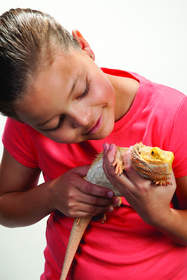MISSION, KS--(Marketwire - Jul 5, 2012) - (Family Features) Curiosity, compassion, companionship -- pets give children the chance to learn about animals and develop healthy, lifelong relationship skills. According to Dr. Alan M. Beck, director of the Center for the Human-Animal Bond at the Purdue University School of Veterinary Medicine, classroom pets provide academic and social benefits.
Classroom Pets Encourage Better Behavior and Performance
Children often view pets as their best friends and as a result, can develop a protective attitude toward animals. This in turn can encourage good behavior. For example, "when a teacher asks his or her students to quiet down because the noise is scaring their pet, they instantly recognize the pet's needs and respond," says Dr. Beck, spokesperson for PetSmart.
In addition to the bond children form directly with the pet, the shared responsibility of caring for an animal can encourage healthy relationships between students. Taking care of a classroom pet -- whether it's a fish, guinea pig or reptile -- gives students a common ground to work as a team, learn to cooperate and form friendships.
Pets can also help shy children and those with performance anxiety, as an animal can be a less intimidating audience for a student than his peers. "Many children struggle with reading aloud, but we've observed that those who practice by reading to their classroom pets eventually overcome their anxiety and do better in school," says Dr. Beck.
Choosing a Classroom Pet
From small animals and fish to reptiles, there are a variety of pets from which to choose. Things to factor into the decision include children's ages, pet-care experience, daily time requirements for care and lifespan. Teachers and parents can stop by a PetSmart store and speak with an associate or visit www.PetSmart.com/Teachers to help make the decision easier.
Curriculum Ideas for Classrooms with Pets
When animals are used as tangible, relatable examples in lessons, students can become engaged and more easily understand the information.
- Mathematics -- Instruct your students to count the amount of food and water your pet needs in a day, week, month or year. You can also calculate the cost of feeding the pet by using play money to illustrate how much each trip to the pet store costs when purchasing supplies.
- Reading -- Encourage students to read aloud to the pet and find reading materials that feature your pet's species.
- Writing -- Ask students to write an adventure story about the classroom pet, then share a new story each week.
- Art -- Introduce your students to new art projects starring your classroom pet.
- Science -- Talk about the natural environment of your pet. You can also explain the difference between diurnal (animals active during the day) and nocturnal (animals active at night) animals.
- Computer Science -- Get permission from your principals and the students' parents to create a blog starring your classroom pet. Ask your students to contribute drawings, stories and to help you write a new entry each day or week.
Pet Care Tips for Parents
The benefits of pet ownership extend beyond the classroom. Whether parents are interested in choosing a family pet, or need pet care tips when it's time to care for the classroom pet at home, the pet care guides at www.MyPetSmart.com/Care-Guides can help ensure pets stay happy and healthy.
About Family Features Editorial Syndicate
This and other food and lifestyle content can be found at www.editors.familyfeatures.com. Family Features is a leading provider of free food and lifestyle content for use in print and online publications. Register with no obligation to access a variety of formatted and unformatted features, accompanying photos, and automatically updating Web content solutions.
Contact Information:
Wendy MacDonald
wmacdonald@familyfeatures.com
1-888-824-3337 ext. 235
http://editors.familyfeatures.com
